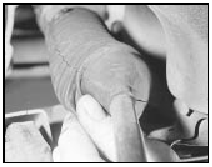Suspension and steering check (Every 6000 miles or 6 months)
Front suspension and steering
check
1 Raise the front of the vehicle, and securely
support it on axle stands (see “Jacking and
Vehicle Support”).
2 Visually inspect the balljoint dust covers and the steering rack-and-pinion gaiters for splits, chafing or deterioration (see illustration). Any wear of these components will cause loss of lubricant, together with dirt and water entry, resulting in rapid deterioration of the balljoints or steering gear.

18.2 Checking a steering gear gaiter
3 Grasp the roadwheel at the 12 o’clock and 6 o’clock positions, and try to rock it (see illustration). Very slight free play may be felt, but if the movement is appreciable, further investigation is necessary to determine the source. Continue rocking the wheel while an assistant depresses the footbrake. If the movement is now eliminated or significantly reduced, it is likely that the hub bearings are at fault. If the free play is still evident with the footbrake depressed, then there is wear in the suspension joints or mountings.

18.3 Rocking the roadwheel to check steering/suspension components
4 Now grasp the wheel at the 9 o’clock and 3 o’clock positions, and try to rock it as before.
Any movement felt now may again be caused by wear in the hub bearings or the steering track-rod balljoints. If the inner or outer balljoint is worn, the visual movement will be obvious.
5 Using a large screwdriver or flat bar, check for wear in the suspension mounting bushes by levering between the relevant suspension component and its attachment point. Some movement is to be expected as the mountings are made of rubber, but excessive wear should be obvious. Also check the condition of any visible rubber bushes, looking for splits, cracks or contamination of the rubber.
6 With the car standing on its wheels, have an assistant turn the steering wheel back and forth about an eighth of a turn each way.
There should be very little, if any, lost movement between the steering wheel and roadwheels. If this is not the case, closely observe the joints and mountings previously described, but in addition, check the steering column universal joints for wear, and the rackand- pinion steering gear itself.
7 Visually check that each lower arm balljoint is correctly located in the hub carrier, ensuring that the Torx type pinch-bolt is fully engaged in the groove in the balljoint stud.
Suspension strut/shock absorber
check
8 Check for any signs of fluid leakage around
the suspension strut/shock absorber body, or
from the rubber gaiter around the piston rod.
Should any fluid be noticed, the suspension strut/shock absorber is defective internally, and should be renewed. Note: Suspension struts/shock absorbers should always be renewed in pairs on the same axle.
9 The efficiency of the suspension strut/shock absorber may be checked by bouncing the vehicle at each corner.
Generally speaking, the body will return to its normal position and stop after being depressed. If it rises and returns on a rebound, the suspension strut/shock absorber is probably suspect. Examine also the suspension strut/shock absorber upper and lower mountings for any signs of wear.
See also:
Sunroof - removal, refitting and adjustment
Glass panel - removal and
refitting
1 Open the sunblind and remove the three
screws and clips shown (see illustration)
then slide the lower frame rearwards into the
roof.
39.1 Sunroof lower fr ...
Thermo-time switch - removal and refitting
Removal
1 Disconnect the battery negative lead.
2 Drain the cooling system as described in
Chapter 1.
3 Raise the front of the car and support it on
axle stands (see “Jacking and Vehicle
Support ...
Specifications
General
Engine type . . . . . . . . . . . . . . . . . . . . . . . . . . . . . . . . . .
. . . . . . . . . . . . . Four-cylinder, in-line overhead camshaft
Capacity:
1.1 litre . . . . . . . . . . ...
